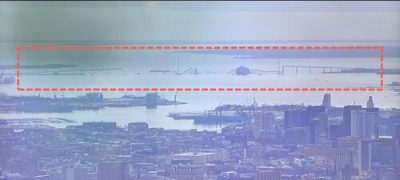The Baltimore Bridge Collapse and Its Impact on Global Trade

All Global Research articles can be read in 51 languages by activating the Translate Website button below the author’s name (only available in desktop version).
To receive Global Research’s Daily Newsletter (selected articles), click here.
Click the share button above to email/forward this article to your friends and colleagues. Follow us on Instagram and Twitter and subscribe to our Telegram Channel. Feel free to repost and share widely Global Research articles.
Global Research Referral Drive: Our Readers Are Our Lifeline
***
- Blocking passage into and out of the Port of Baltimore, the wreckage is shutting down ninth largest harbour in the US, a vital link to both Southeast Asia and China
- China was Baltimore’s No 2 import and No 3 export destination in 2023, and a leading consumer of coal shipped through the port
Three days after the Francis Scott Key Bridge crossing the Port of Baltimore was struck by a container ship and collapsed, killing six, officials have turned to restoring the vital shipping lane that is now unpassable with debris.
Early on Tuesday, the 984-foot (300-metre) Dali lost power and diverged from the standard path before crashing into one of the bridge’s pillars. Though traffic had been stopped on the bridge after the crew transmitted a distress signal, six construction workers and their vehicle plunged into the river.
Bodies of two of the six have been recovered. Search for others was halted on Thursday as the debris made it dangerous for divers to continue. The ship also has some containers with hazardous material.
All 22 crew members, almost all from India, have remained aboard the vessel and have been questioned by a team of the National Transportation Safety Board. Investigators have obtained the ship’s data recorder and so far ruled out foul play.
Clean-up and Rebuild
The US government has announced US$60 million in emergency relief aid for early recovery and clean-up.
President Joe Biden has pledged to fund the rebuilding of the 47-year-old bridge that handled 11.3 million crossings annually. It is expected to take more than a year to construct a new bridge.
On Friday, a 1,000-ton (907-tonne) crane, the largest on the east coast, arrived on the disaster scene to help clear the waterway. Federal and state authorities say it remains unclear how long it could take to resume cargo traffic.
The twisted wreckage of the 2.6km (1.6 miles) bridge – pieces of which are still wrapped around the Dali, which carried 4,700 cargo containers – is blocking freighters from sailing the only channel that connects the port to the Atlantic Ocean.
Supply chain threat
That’s bad news for global supply chains as east coast ports in the US have become more significant in recent years with Washington’s push for “friendshoring”.
US east coast ports have been gaining market share of both total and Asian imports compared to Pacific ports – a result of factors like the pandemic and trade wars, but also supply chain issues like congestion, infrastructure expansion and efficiency.
The US has been boosting its trade with so-called friendly countries while trying to diversify away from China amid geopolitical tensions.
More trade with China is done via US west coast ports while shipments to and from South Asian countries like Vietnam, Malaysia, India, Bangladesh often use the east coast ports despite their farther distance. Indeed, the Dali, registered in Singapore, was bound for Sri Lanka.
Click here to read the full article on SCMP. * Note to readers: Please click the share button above. Follow us on Instagram and Twitter and subscribe to our Telegram Channel. Feel free to repost and share widely Global Research articles.

